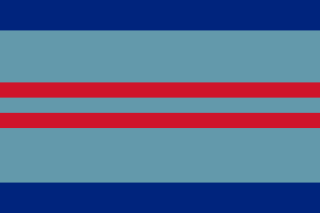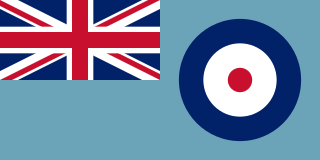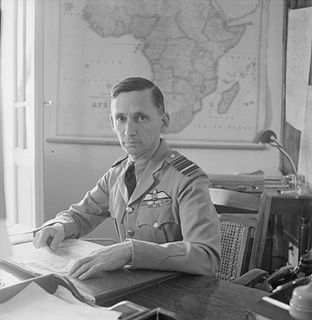Related Research Articles

Marshal of the Royal Air Force (MRAF) is the highest rank in the Royal Air Force (RAF). In peacetime it was granted to RAF officers in the appointment of Chief of the Defence Staff (CDS), and to retired Chiefs of the Air Staff (CAS), who were promoted to it on their last day of service. While surviving marshals of the RAF retain the rank for life, the highest rank to which officers on active service are promoted is now air chief marshal. Although general promotions to Marshal of the Royal Air Force have been discontinued since the British defence cuts of the 1990s, further promotions to the rank may still be made in wartime, for members of the Royal Family and certain very senior RAF air officers in peacetime at the discretion of the monarch; all such promotions in peacetime are only honorary, however. In 2012, Charles, Prince of Wales was promoted to the rank in recognition of his support for his mother, the Queen, in her capacity as head of the armed forces (commander-in-chief), while in 2014 Lord Stirrup, who had served as Chief of the Air Staff and Chief of the Defence Staff for over seven years, was also promoted.

Air vice-marshal (AVM) is a two-star air officer rank which originated in and continues to be used by the Royal Air Force. The rank is also used by the air forces of many countries which have historical British influence and it is sometimes used as the English translation of an equivalent rank in countries which have a non-English air force-specific rank structure. Air vice-marshals may be addressed generically as "air marshal".

Marshal of the Royal Air Force Arthur William Tedder, 1st Baron Tedder, was a senior Royal Air Force commander. He was a pilot and squadron commander in the Royal Flying Corps in the First World War and he went on to serve as a senior officer in the Royal Air Force during the inter-war years when he served in Turkey, Great Britain and the Far East.

The Chief of the Air Staff (CAS) is the professional head of the Royal Air Force and a member of both the Chiefs of Staff Committee and the Air Force Board. The post was created in 1918 with Major General Sir Hugh Trenchard as the first incumbent. The current and 30th Chief of the Air Staff is Air Chief Marshal Sir Michael Wigston, who succeeded Sir Stephen Hillier in July 2019.

Lieutenant general, formerly more commonly lieutenant-general, is a senior rank in the British Army and the Royal Marines. It is the equivalent of a multinational three-star rank; some British lieutenant generals sometimes wear three-star insignia, in addition to their standard insignia, when on multinational operations.

Air Chief Marshal Sir James Milne Robb, was a senior Royal Air Force commander. After early service in the First World War with the Northumberland Fusiliers, Robb joined the Royal Flying Corps and became a flying ace credited with seven aerial victories. He was granted a permanent commission in the Royal Air Force in 1919 and commanded No. 30 Squadron RAF in the Iraqi revolt against the British. In 1939, Robb travelled to Canada to help establish the Empire Air Training Scheme, a massive training program that provided the Royal Air Force with trained aircrew from Canada, Australia, New Zealand and Southern Rhodesia. He commanded No. 2 Group RAF of RAF Bomber Command and No. 15 Group RAF of RAF Coastal Command.

The Air Member for Personnel (AMP) is the senior Royal Air Force officer who is responsible for personnel matters and is a member of the Air Force Board. The AMP is in charge of all aspects of recruiting, non-operational flying and ground training, career management, welfare, terms, and conditions of service, and resettlement for RAF regular, reserve, and civilian staffs worldwide.
Air Staff is the body of Royal Air Force officers responsible for the running of the RAF. Generally, the heads of the various departments of the Air Staff formed, together with members of the Air Ministry, the Air Council.
The Inspector-General of the RAF was a senior appointment in the Royal Air Force, responsible for the inspection of airfields. The post existed from 1918 to 1920 and from 1935 until the late 1960s. For much of World War II, a second inspector-general post existed.
The Deputy Chief of the Air Staff (DCAS) was a senior appointment in the Royal Air Force. The incumbent was the deputy to the Chief of the Air Staff. The post existed from 1918 to 1969. Today, the Chief of the Air Staff's deputy is titled as the Assistant Chief of the Air Staff.
Air Chief Marshal Sir Edmund Cuthbert "Teddy" Hudleston, was a senior commander in the Royal Air Force.
The Commandant of the Royal Observer Corps (CROC) was the Royal Air Force commander of the Royal Observer Corps. All the holders of the post were RAF officers in the rank of Air Commodore, initially retired reserve officers then Auxiliary officers and, since the end of World War II, serving officers. The ROC was a uniformed civilian branch initially under the control of the Air Defence of Great Britain organization, then Fighter Command and latterly Strike Command. The Royal Observer Corps existed from 1925 until it was stood down in 1995. Most of the commandants, with only three exceptions, were qualified RAF pilots, two being air navigators and the other a General Duties (Ground) Supply Branch officer. If a Royal Observer Corps officer had ever held the appointment, they would have held the rank of Observer Commodore.

Air Chief Marshal Sir Douglas Claude Strathern Evill, was an Australian-born Royal Naval Air Service pilot and squadron commander during the First World War. Serving in the Royal Air Force between the wars, he was a senior air commander during the Second World War.
Air Chief Marshal Sir Michael James Douglas Stear, was a senior commander of the Royal Air Force (RAF). He served as Deputy Commander in Chief, Allied Forces Central Europe from 1992 to 1996.

No. 219 Squadron of the Royal Air Force was founded in 1918 and disbanded in 1957 after four separate periods of service. During the First World War it served as a coastal defence unit, and through most of the Second World War and the 1950s it operated as a night fighter air defence squadron. Three commanders of the squadron went on to be Chiefs of the Air Staff, two of the RAF and one of the Royal Pakistani Air Force.

Air Chief Marshal Sir Charles Edward Hastings Medhurst, was a First World War Royal Flying Corps pilot on the Western Front and later a senior officer in the Royal Air Force.

Middle East Command was a command of the Royal Air Force (RAF) that was active during the Second World War. It had been preceded by RAF Middle East, which was established in 1918 by the redesignation of HQ Royal Flying Corps Middle East that had been activated in 1917 although a small Royal Flying Corps presence had been operational in the region since 1914.
Controller Aircraft (CA), originally Controller of Aircraft, is a senior British Ministry of Defence appointment who is responsible for delivering an airworthy aircraft to the Services, whereupon the Service issues a Release to Service (RTS), releasing the aircraft into service. The difference between CA Release and RTS is normally one of Build Standard. Although usually held by a Royal Air Force officer, several civil servants have held the post in the 20th century. The incumbent is a member of the Air Force Board.
The Air Member for Materiel is the senior Royal Air Force officer responsible for procurement matters. The post-holder is a member of the Air Force Board and is in charge of all aspects of procurement and organisation for RAF regular, reserve and civilian staffs worldwide.
References
- ↑ Dow, James (1997). The Arrow. James Lorimer & Company. p. 114. ISBN 978-1-55028-554-3.
- ↑ Mackie, Colin. "Senior Royal Air Force Appointments" (PDF). gulabin.com.
- ↑ Barrass, M. B. "Sir Richard Peirse". Air of Authority – A History of RAF Organisation.
- ↑ Barrass, M. B. "Sir Wilfrid Freeman". Air of Authority – A History of RAF Organisation.
- ↑ Barrass, M. B. "C E H Medhurst". Air of Authority – A History of RAF Organisation.
- ↑ Barrass, M. B. "Sir Arthur Tedder". Air of Authority – A History of RAF Organisation.
- ↑ Hatch, Alden (1944). General Ike, A Biography of Dwight D Eisenhower. Chicago: Consolidated Book Publishers.
- ↑ Barrass, M. B. "Sir Douglas Evill". Air of Authority – A History of RAF Organisation.
- ↑ "No. 37597". The London Gazette (Supplement). 4 June 1946. p. 2751.
- ↑ Barrass, M. B. "Sir William Dickson". Air of Authority – A History of RAF Organisation.
- ↑ Barrass, M. B. "Sir James Robb". Air of Authority – A History of RAF Organisation.
- ↑ Barrass, M. B. "Sir Arthur Sanders". Air of Authority – A History of RAF Organisation.
- ↑ Barrass, M. B. "The Honourable Sir Ralph Cochrane". Air of Authority – A History of RAF Organisation.
- ↑ Barrass, M. B. "Sir John Baker". Air of Authority – A History of RAF Organisation.
- ↑ Barrass, M. B. "Sir Ronald Ivelaw-Chapman". Air of Authority – A History of RAF Organisation.
- ↑ Barrass, M. B. "Sir Edmund Hudleston". Air of Authority – A History of RAF Organisation.
- ↑ Barrass, M. B. "Sir Wallace Kyle". Air of Authority – A History of RAF Organisation.
- ↑ Barrass, M. B. "Sir John Nicholls". Air of Authority – A History of RAF Organisation.
- Barrass, M. B. "Air Council Appointments". Air of Authority – A History of RAF Organisation.